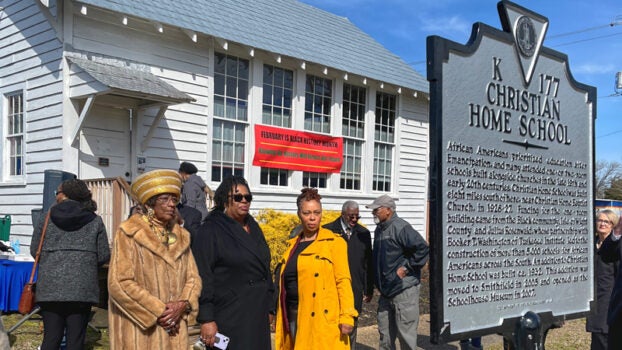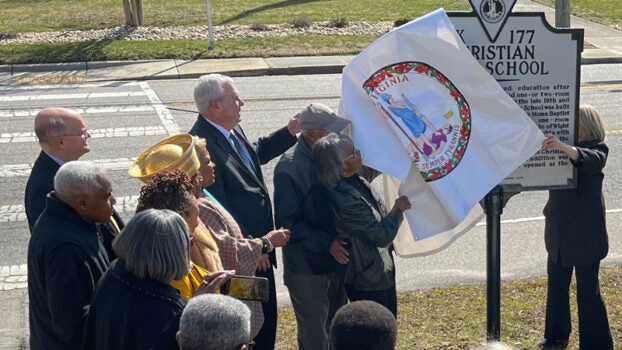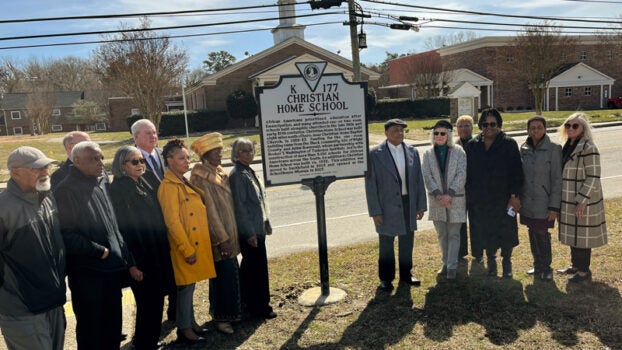Highway marker at Schoolhouse Museum unveiled
Published 9:50 am Friday, March 1, 2024
Virginia’s historical highway marker program is now “one step closer” to a “full and complete telling” of the state’s past.
That was how Julie Langan, director and preservation officer for the Department of Historic Resources, described the Feb. 25 unveiling of the DHR’s latest highway sign at the Schoolhouse Museum in Smithfield, which commemorates the building’s history as the former Christian Home School.
In the late 19th and early 20th centuries, many children of formerly enslaved African Americans attended one- or two-room schoolhouses built alongside churches. In 1926, Isle of Wight County’s Black community partnered with former Sears, Roebuck and Co. President Julius Rosenwald to raise money for a schoolhouse near Christian Home Baptist Church at Isle of Wight’s border with present-day Suffolk.
The former Christian Home School was one of more than 5,000 Rosenwald built in partnership with Tuskegee Institute founder Booker T. Washington across the American South. The circa-1932 addition, now a standalone structure on Main Street, was moved to its present location in 2005 and opened as a museum two years later as the town’s Jamestown 2007 project to commemorate the 400th anniversary of the 1607 arrival of English settlers. The museum is dedicated to the educational experience African Americans of the early 20th century would have had attending one- and two-room schoolhouses of the era.
“From there to here, from then to now, if the walls of this building could talk what stories would they tell? What history would be unveiled?” Schoolhouse Museum President Jessie Linyear said. “Let me share with you what I believe these walls would say. … Like other schools built around this time period, I was built to provide a place for Black children to be educated. Recognizing the importance of preserving history, a steering committee was formed to bring me to historic Smithfield. I was opened as an African American history museum in 2007. Without the foresight and the determination of the dedicated steering committee members I would not be here.”
The museum’s board of directors petitioned and received approval from DHR for a highway marker in 2022. The cast aluminum double-sided signs feature the state seal and black lettering against a silver background.
Virginia has erected more than 2,600 markers along its roadway since 1927, with many of its earliest signs focused on sites with national or state-level importance.
According to Langan, a full third of the first 700 markers erected before 1930 were Civil War-focused and only three spoke to Black history. Now, the number of Black history-related markers has risen 451, or 17% of the more than 2,600 statewide.
Over the past five years, 63% of all new markers have focused on Black history. The Christian Home School sign is the first of 16 in Isle of Wight focused specifically on the county’s Black history.
“We are striving for a balanced rather than a skewed interpretation of the past and while we’re proud of how far we have come we are well aware that we still have a long way to go before the programs honestly and fairly represent the contributions of all Virginians – indigenous peoples, African Americans, women and other underrepresented groups,” Langan said.
Smithfield Mayor Steve Bowman, Vice Mayor Valerie Butler and Town Council members Jeff Brooks and Jim Collins attended the unveiling ceremony, held outside the museum at 11:30 a.m., as did Town Manager Michael Stallings, Isle of Wight County School Board member John Collick, Isle of Wight County Museum Director Jennifer England and state Del. Otto Wachsmann, R-Sussex, whose district includes Isle of Wight.








